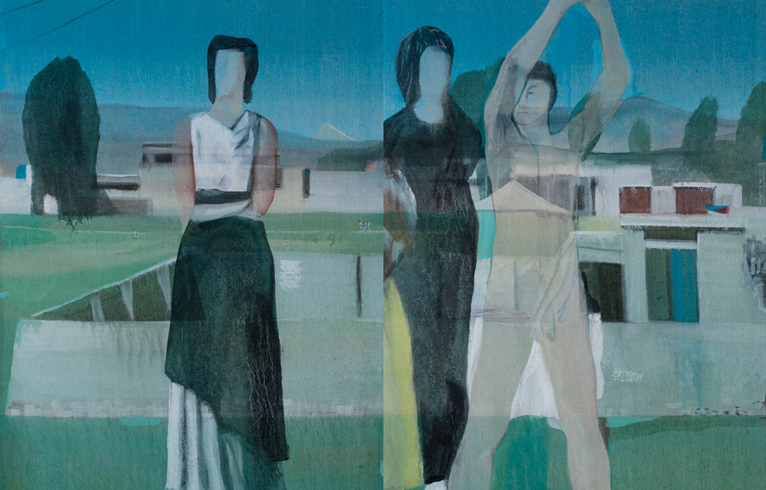MARC DESGRANDCHAMPS
| February 23, 2012 | Post In LEAP 12

The paintings of the 51-year-old French artist Marc Desgrandchamps call to mind a number of key figures in the Western artistic tradition: Manet, Cézanne, Degas, or even the sculptures and architecture of ancient Greece. Traces of the styles of past masters appear continually in his works, though they still retain characteristically modern touches. Desgrandchamps concerns himself with the passage of time, and its corresponding relationship with space. Although artists have pondered these themes since at least the time of the Renaissance, rather than engaging them empirically, Desgrandchamps approaches them in a fragmentary, non-logical fashion.
The elements comprising his works are extremely simple, as are the colors he uses in them: horses, clothes, nude bodies, and human forms, both partial and whole, share canvases with huge swathes of blue, green, gray, dark red, and yellow the color of wet earth. He does this without abandoning form. Within his works, one can discern the shapes of people and objects, even if they have been attenuated almost to the point of abstraction. In one of the artist’s works from 2011, four women are place in front of a blurred, ancient-looking building. From one woman to the next, the fine details of dress shift slightly from ancient to modern, signifying human evolution. At one side of the painting, only a portion of the most modernly clothed woman’s body appears, almost as she has leapt out of the painting, moving somewhere beyond the canvas’s reach. In the same way, time itself seems to flow horizontally out from the frame. Another work from the same year juxtaposes three people, but no matter whether it is people, clothing, or nude bodies, each conveys the same breed of concept. All his works defy interpretation, some even declining to take a name apart from a simple Untitled. It seems as if Desgrandchamps hopes for the viewer to focus on the experience that lies within the canvas.
The artist’s early works were filled with severe shapes, the spaces between lines relatively clear. His focus on structure is still present in his most recent works, as numerous sketches in the show’s accompanying volume testify. It is a habit born of expertise, one that emerges in the concepts for Desgrandchamp’s paintings. The new paintings at this show all exhibit a light touch. In many of them, the paint has been diluted with turpentine, and applied in almost-invisible layers to the canvas, the shades of oil paint bleeding together like watercolors. Lines and shapes are likewise rendered lithely and loosely. The works emanate a poetic expression not unlike that of Chinese painting. Word has it that the works owe their creation to the awe inspired in the artist by the Forbidden City and other ancient sites during his visit to Beijing several years ago. That may be one reason Eastern influences are as readily apparent in the pieces as are Western ones.
“Restoring to visibility a burst of reality, such as it could appear to me momentarily in the movement of the world… is an attempt to build, construct in representation what I call the monumental.” Desgrandchamp’s words sound like the sigh of an artist prior to the invention of photography when confronted with an awesome-but-ephemeral natural spectacle. He emphasizes the experience of the individual artist: “This is not an act of preservation, but rather the attempt to restore.” Herein lies the difference between painting and photography; perhaps, as far as “restoring reality” is concerned, photography has forever usurped the function in human society that painting once held, even if painting will forever have unto itself a unique role in revealing “the experience of the individual when faced with reality.” Through works like those of Desgrandchamps we will always be able to discern information about the individual, even if that information is not developed in a philosophically logical way, even if it would rather namelessly call itself Untitled. Liu Xi (Translated by Matthew Schrader)

